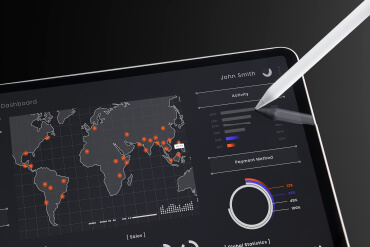Today, banks must respond to challenges such as increased client expectation, aggressive competition, acquisitions, and mergers. Decision making is a crucial part of banking management. The decisions should be timely and efficient, driven by business intelligence. Modern banks record a large amount of data on clients’ attributes such as personal, psycho-social, account transactions, credit liabilities etc. The data is securely stored in transactional databases. Researches show that transactional databases provide rich information source that can be used for enhancing the banking business.
The revolution in Information and Communication Technologies offers solutions to the critical problems in the banking sector. Out of which, Business Intelligence (BI) is a separate discipline that encompasses elements of IT, strategy, managerial accounting, analysis, and marketing. It empowers banks to collect, analyze, disseminate, and act based on the business data. Data Warehouses (DW) are generated to meet the challenges in building a Business Intelligence Solution. Data Warehouse with OnLine Analytical Processing (OLAP) creates the informational basis for BI. It covers many areas of the banking business such as analytical customer relationship management, bank performance management, enterprise risk management, asset & liability management, and compliance.
Evolution of Business Intelligence in Banks

Manual Systems
Manual systems were used before the advent of computers. This is when the banking operations were considerably small and limited. It involved the manual recording of transactions and the generation of reports from manual ledgers. The reports are consolidated with other branches into a final report. BI was limited to simple reporting based on the banking transactions.
Computer-based Systems
As banks scaled their channels and global presence, the transactions jumped multifold. Manual reporting became passé, time-consuming and error-prone with redundancy. It was unequal to the task completed by automated systems. Banks started to increasingly depend on IT to manage the huge volume of data. MS Excel spreadsheets were consolidated at the bank levels using computer-based systems. But they were limited to banking transactions and did not help banks to make timely and smart decisions.
MIS Systems
The quest for decision making support led to the Management Information Systems (MIS). They are the specialized tools used in the Business intelligence Framework. These systems digest banking data into deep insights that aid business decisions. Now, the scope of Business Intelligence extends beyond simple banking transaction reporting to other areas that directly impact the banking business.
Applications of Business Intelligence in Banks

Trend Analysis
To strategize the future course of action, banks need to analyze the historical data of branches, employees, deposits, loans, sales, expenses, profit, loss, and other factors. The data can be collected and organized by product, sector, customer profile, region, timing, or the banks’ distribution structure. Business Intelligence tools analyze the data into metrics such as product profitability, business per employee, understanding of customers’ needs, gaps, identification of thrust areas and new market opportunities. BI provides deep insights on products that need to be re-priced, products that need to be removed, and new relevant products to be launched.
Customer Relationship Management (CRM)
Customer Relationship Management is the key driver for success in any organization. Banks relationship with customers has gone beyond banking. Today, Customer Relationship Management offers deep insights into customers’ behaviour, preferences, and current needs. It helps banks to improve their products, services, and sales. Business Intelligence support to transform the product-oriented CRM model into customer-centric. It finds hidden patterns, trends, and correlations by analyzing the huge volume of data. It also helps to identify and retain profitable customers while filtering out those who are not.
Risk Management
Risk is an integral part of banking. It may be financial, non-financial, or uncertainty risk. It can be mainly classified as credit, market, or operational risk. The likelihood of the borrower defaulting on obligations is referred to as credit risk. Business Intelligence can support banks to mitigate the risk by providing insights on risky borrowers by analyzing borrowers’ past dealings and transactions. It helps to statistically predict their future behaviour. It further helps banks to refine their lending mechanism. Risks arising out of market fluctuations is called market risk. To strengthen the bank’s portfolio, analysis of historical data and highlighting opportunities for diversification or lowering the exposure to a particular borrower, is the need of the hour. Similarly, asset-liability management can be handled effectively. Risk arises out of human error, fraud, or natural disaster comes under operational risk. Human errors and frauds can be identified with proper audit and stronger internal controls. BI helps banks to keep track of financial and non-financial transactions of employees and other stakeholders to find the slightest deviation from set processes. It ensures transparency in banking transactions to mitigate the risk.
Compliance
Banks are mandated to send various reports to regulatory authorities including Reserve Bank of India, Securities and Exchange Board of India, Credit Information Bureau of India Limited etc. This is a part of compliance with anti-money laundering and other norms. For instance, RBI requires the details of foreign exchange transactions by designated branches, a list of complaints filed against the bank, and exposure to various sectors regularly. Credit Information Bureau requires the credit information of individuals and enterprises to identify the defaulters. Banks are expected to maintain data on all events and transactions to generate data-driven reports. BI helps banks to collect all the relevant data, organize, and present it in the required formats.







